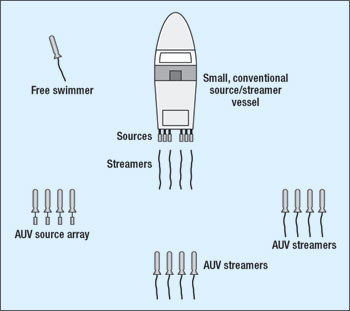What's new in exploration
High-speed mountains; AUV seismic
In looking back at the history of seismic acquisition, one thing strikes me: a lot of “crazy” ideas have come and gone. More recently, I’ve noticed that some of the things that, back in 1997, were either deemed unimportant or unachievable, have now become common. Back then, on numerous occasions, when discussing fledgling 4D projects, I would make a statement such as, “Wouldn’t it be nice to know, with great precision, exactly where each shot and each receiver was?” The answer was usually, “Of course, but it’s not necessary. We can do a lot in processing.” Well, as it turns out, some manager would always ask a question like, “So, are you sure that what we’re looking at is a true 4D signal, and not some artifact? Are you $20 million sure?” Similar statements can be made about anisotropy, noise, and so on. Nowadays, operators are increasingly insisting on: as-precise-as possible source and receiver positioning; source strength/ signature repeatability; wider apertures and more azimuths (within budgetary constraints); and all done, of course, as cheaply as possible. Simply put, they want to reduce uncertainty. Contractors and oil companies have met these challenges, with quieter streamers, improved sensor designs, more precise control of all source and receiver attributes, as well as increased offsets and multi-azimuthal acquisition, to name a few. With this in mind, it occurs to me that some day, many aspects of marine seismic acquisition will be done by AUVs. This is where you probably think that a screw has finally come loose, and one of my frontal lobes just plopped out onto my keyboard. Well, perhaps. But I’ll bet that there are some other “screwballs” already thinking about it – and I’d like to hear from them. We know that some sub-bottom seismic and bathymetry is already being acquired by AUVs. But as the drawing on this page shows, that’s not what I’m talking about. Are a small fleet of AUVs too expensive? Not really, when one considers that a modern seismic vessel can cost $70 to $100 million or more when outfitted, and carries a crew of 30 to 60. There should be ample room for cost savings.
Solid state streamers combined with solid state electronics can make streamers – which are already getting thinner – thinner still. This will be necessary to optimize the limited power onboard an AUV, or even mini-submarine-sized AUVs. Streamers and sources can be towed in arrays or range as “free swimmers.” Positioning should not be a problem. There exists a full complement of long- and short-baseline positioning systems, acoustic nets, even seafloor beacons in some cases. All of which are ultimately GIS referenced. Just as important, AUVs need not be limited to the near surface. They can prowl much deeper than surface-towed sources and sensors, with less interference from surface noise and other influences. A source-towed by an AUV can be much closer to the seafloor, even in deepwater, yielding significant (hopefully beneficial) changes in surface reverberations, notch effects, and the amount of acoustic energy injected into the seafloor, not to mention happier marine mammals and environmentalists. But AUV-towed sources present some unique challenges. The biggest of which is the physics of energy density – they simply cannot store enough energy onboard to provide sufficient subsurface acoustic energy. Unless, of course, it comes from chemical energy. One possibility is pure metal reactions, such as a roll of pure metal zinc wire that, when heated in a small chamber with water, creates hydrogen and steam, the latter causing the bubble to quickly condense. Or perhaps a revisit to the 1960’s marine explosives department. I’m thinking of some sort of revolving gun with 17,000 “bullets,” delivering an explosive bullet every five seconds or so into the water column. Of course, the oscillating gas-bubble problem will have to be solved, but some sort of mechanical device, piston, diffuser, or completely different chemical explosive should be able to kill the bubble. I’m thinking way out of the skybox here – more like in the loony bin. But then again, we’re way past the 1960s. High-speed mountain. For many years there has been a geologic mystery in northwestern Wyoming: The Heart Mountain block slide. It is one of the largest such slides known to have occurred in Earth’s history. The big clue is the kilometer-sized chunks of Paleozoic rock that is sitting atop Tertiary sediments, some 250 million years younger. Heart Mountain is one of those blocks. Occurring in the early Eocene, the slide covers an area of over 1,300 mi2 (3,400 km2). It moved at least 30 mi across open terrain on a slope of about 2°. The block was initially 2 to 4 km thick. How such as massive block could slide so far on such a gentle slope has been quite a mystery. A paper in the March issue of Geology posits an explanation, part of which has been proposed before by Voight. According to authors Einat Aharonov and Mark Anders of the Weizmann Institute of Science, the huge blocks moved due to magmatic dike injections. These dikes, in turn, heated water that was trapped in a dolomitic layer. Overpressured pore fluids allowed the block to float, and then race down the gentle slope, according to the authors, at speeds exceeding 60 mph! At least that’s what a computer model said.
|
|||||||||
- Prices and governmental policies combine to stymie Canadian upstream growth (February 2024)
- U.S. producing gas wells increase despite low prices (February 2024)
- U.S. drilling: More of the same expected (February 2024)
- U.S. oil and natural gas production hits record highs (February 2024)
- Quantum computing and subsurface prediction (January 2024)
- U.S. upstream muddles along, with an eye toward 2024 (September 2023)





